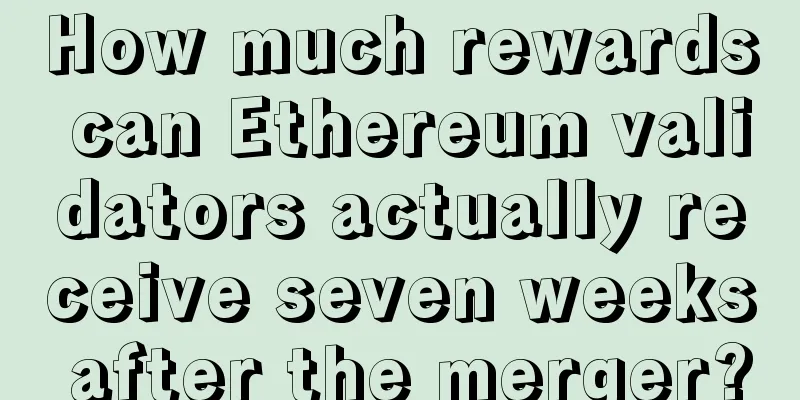How much rewards can Ethereum validators actually receive seven weeks after the merger?

|
Original text: "Ethereum Merge Scams: How Scammers Took Advantage of The Ethereum Merge to Make Millions" by ERIC JARDINE On September 15, 2022, the Ethereum merge officially took place (block height 15537394 on the execution layer and slot 4700013 on the consensus layer). Now, 6 weeks have passed since the merge, and we have also collected relevant data from 2 directions (PoS validator rewards and merge-related scams) and drawn some interesting conclusions. The actual rewards received by PoS validatorsLet’s first look at the distribution of rewards actually received by PoS validators. We can draw the following five conclusions:
Merger scams surge in SeptemberDuring the merger, scams related to the merger stole $1.2 million worth of ETH and became the main scam category in the Ethereum ecosystem. Most merger scams work in a classic way — scammers (often posing as celebrities) trick victims into sending a certain amount of cryptocurrency in order to “upgrade” to the new Ethereum blockchain and receive more in return (usually double the victim’s initial payment). The scam invites users to send 1 ETH to an address and receive 2 ETH in return. This strategy worked many times, as shown in the figure below. On the day of the Ethereum merger, the scam saw a huge spike in revenue, swindling over $905,000 worth of ETH, while all other Ethereum scams swindled less than $74,000. However, the fraud spike quickly fell back to normal levels within a few days, and scams related to the merger almost disappeared by the end of September. Merger scams accounted for eight of the top ten Ethereum scams on September 15. Surprisingly, scams related to the merger had an 83% success rate on September 15, the day of the merger, and a 100% success rate in the days before and after the merger. Such success rates also indicate that scammers are targeting users who lack knowledge about the merger. Scammers tend to defraud users in the country they live in (probably due to language barriers). In the chart below, we can see some of the countries most affected by the merger scam in September, with the second axis showing the connection to other Ethereum scams. In the chart, the United States and India have the most victims of merger scams. Merger scams also appear to target certain developed countries. Finland, for example, is surprisingly "scammed," with three scams targeting only Finland. SummarizeWith DeFi hacks dominating recent headlines, fraud using traditional tactics remains the largest form of crime in crypto. Fraud that exploits user trust will severely impact cryptocurrency adoption. Changes in the crypto industry like mergers are windows of opportunity for scammers, and users’ lack of knowledge can be exploited by bad actors. The surge in “merger”-related scams clearly shows that the blockchain industry needs to work hard to educate users on what terms such as “merger” mean and what common scams should be avoided. |
>>: CZ took over FTX but set off the real Lehman Brothers in the crypto world
Recommend
CZ took over FTX but set off the real Lehman Brothers in the crypto world
At 0:00 am on November 9, SBF posted a tweet on h...
The most devoted facial features
The most devoted facial features When men and wom...
A man who is always gentle and patient with his lover has a high nose bridge.
What kind of men do women like most? Then he must...
Media: All future RTX 30 series graphics cards from Nvidia will be equipped with Ethereum mining restriction function
According to BlockBeats, Videocadz reported that ...
Coinbase: 10 charts to illustrate the trend of the crypto market in the first half of 2024
summary We looked at the growth of total value lo...
Will Bitcoin be as short-lived as the popular simulation game "Second Life"?
The 3D virtual game "Second Life", laun...
What does a woman who is prone to divorce look like? What are the characteristics?
It is said that appearance reflects the heart and ...
Factors that drive crypto market trends
Chairman Mao Zedong has two classic articles that...
Why does Bitcoin require mining, while other cryptocurrencies don’t?
Bitcoin miners do not need to wear hard hats or g...
Palmistry of a woman who will be treated like a doll by her husband
Palmistry of a woman who will be treated like a d...
Are fat people with big faces really a sign of good fortune?
Zhao Liying has grown from a rural girl to the ra...
Palmistry teaches you how to read the love view of men and women
Love is like a mystery from the beginning. Who wi...
Behind Coinbase's IPO: Chinese capital enters the market, valuation may reach $28 billion
Original title: "Behind Coinbase's listi...
Will Solana Surpass Ethereum?
At the end of a recent article, a reader left a m...
Is the Yingtang area between the eyebrows? What does a mole between eyebrows mean?
As one of the traditional physiognomy techniques, ...









